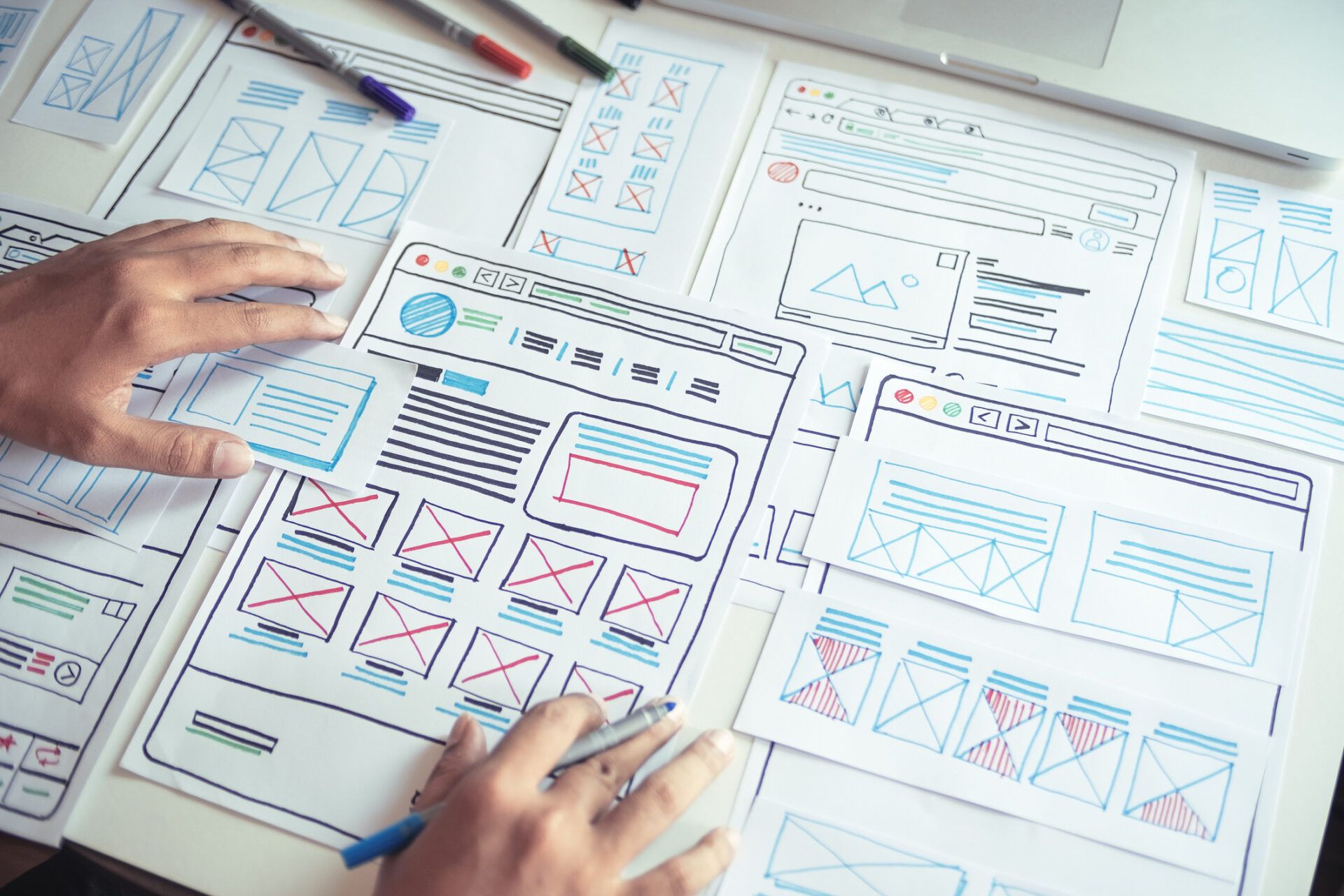There is no single, correct way to present your brand online, but there are some elements that are universal. Building an effective website that presents a brand’s personality promotes more connections with the target audience and attracts new customers. A website that ignores or is inconsistent with a brand’s image and personality misses the opportunity to shape public perception of it.
In this sense we can compare building a website to building a personal profile on a social network. The photos, the information, the type of content shared, and the tone of voice shape people’s perception of your personality. A company’s brand works in the same way, with this construction being done through elements that we will address in this article.
A website with communication focused on the characteristics of a brand, besides generating awareness, is capable of strengthening the connections with clients and potential clients because it will be adequate to what your target audience expects. And these emotional connections are key to building a loyal customer base.
Check out 10 tips for developing websites with your brand’s personality!
1. Define your brand personality
The first step in developing websites for your brand is to have your brand personality well defined. Some steps that help in this process are market research and defining your target audience (and personas, if possible) to understand what kind of brand personality resonates most with them.
A brand personality is a set of characteristics and behaviors applied to the brand’s image and voice. There are five main types of brand personalities, with the possibility of overlap and variation among them:
Competent – reliable, professional, intelligent
Rugged – tough, outdoorsy, irreverent
Sophisticated – Refined, charming, prestigious
Exciting – Imaginative, daring, fun
Sincere – Honest, warm, wholesome
As your site is built, you need to keep an eye on whether all the choices, visual and textual, are appropriate to the personality you have chosen for your brand.
2. Give importance to visual identity
Visual identity is a critical part of building a strong brand. Devote effort to creating a consistent look and feel for how your brand appears in the world and increase its impact on your audience. And remember: content with images gets 94% more views than content without images (Content Marketing Institute). For example, a blog post with images usually gets 35% more shares.
A brand with a consistent visual identity expands and generates more traffic to its site. This is because people are able to quickly recognize your brand (which increases the chances that they will refer your business), your content is more likely to be remembered, there is an increase in credibility, and there is a greater likelihood that the brand will generate connections with the audience that identifies with its personality.
3. Make good use of your logo
Your logo is the face of your brand, and consequently plays an important role in the aesthetic settings of your website. Creating a logo involves choosing a combination of icons, typography, and colors that best represent your company’s products, values, and personality.
An interesting point when creating logos is the choice of their colors. Color psychology is a well-researched field and can have an impact on customer perceptions of your brand. It is worth researching more on the subject.
After creating the logo, it is recommended to use it on the home page of your website, in the upper left corner of each page.
4. Work on the colors of the brand
Base the color palette of your site on the colors of your logo. Consider what colors to use for the background, navigation bars, and featured text such as CTAs and titles.
Follow your brand’s style guide, which should contain the primary and secondary colors, and list the Pantone, RGB, CYMK, and Hex codes for each color. This ensures that anyone creating content for your brand uses the same colors. If your brand doesn’t already have a style guide, it’s time to create one.
5. Use an image family
We have already mentioned a bit about the importance of using images on your website to create a visual identity. Now you need to understand that the important thing is not only to use them, but to maintain a consistency between them, providing a visual unity as if they were part of the same family.
The images or illustrations that you will use for your brand also need to complement the color palette of your visual identity and logo. And make sure that the colors of the images do not clash with the logo or the background of the site.
It is also recommended that you create your own photos and images, avoiding the use of image banks (their use is more common for illustrating blog posts, for example). When it is necessary to use image banks, it is critical that you use only those for which you have permission to use and that you follow all attribution requirements to avoid possible copyright violations.
One feature that is being used more and more is the use of color overlays: a layer of semitransparent color over the image, or a part of it, transforming a generic image from the image bank into a brand-appropriate image. Color overlays also aid legibility when text is superimposed on the image.
In addition to color overlays, you can also use other design elements for your brand, such as textures, shapes, borders, lines, and swirls. The point is to use something that your audience will see repeatedly in your materials and will generate brand recognition.
6. Create and/or use templates
In order to speed up the processes of creating your website, social media, and any graphic materials for your brand, a widely used practice is the creation of templates, a group of master layouts.
It is through the templates that you will facilitate the understanding of how you want your brand’s future images to be created. When creating your template collection, consider the formats your team uses most, whether for long quotes, short quotes, blog posts, sales materials, presentation materials, etc.
Specifically for website development, there is also the possibility of using templates provided by platforms such as wordpress, for example, which also allow for editing. Define what kind of website your business needs before you decide on a template, so that its design supports your goals. Many of these templates also come with font packages, icons, and illustrations, which can help you maintain a cohesive visual identity.
7. Define your typography
With the visual elements of your brand already defined, it’s time for you to worry about the language. How your brand speaks, the type of vocabulary and its tone of voice are some of the elements that also help define your personality.
One such element is the typography of the materials produced for your brand, which refers to the fonts and how they are used. Be careful to maintain consistency between primary and secondary fonts. Typography should also be defined in the brand’s style guide.

8. Consider the use of a tagline
Not all companies make use of a tagline or slogan, but it is an excellent way to add personality to the brand. A good example of a tagline is Nike’s “Just do it,” which makes the brand memorable, encouraging, and motivational, fostering connection with consumers.
The tagline can be used next to the logo. On the website, it is usually used on the home page, so that users will see it as soon as they enter the site. You can also explain a little more about the tagline on the “About Us” page.
9. Write texts and blog posts with your brand voice
All text on your site also needs to have your brand voice, including navigation bar headers, general site text, titles and subheadings, and FAQs. Remember that every interaction you have with your customers – from long, engaging posts to tiny texts – shapes their perception of your brand.
It has become increasingly clear to marketers the benefits of a blog for a company. Blog posts, as well as being excellent for building SEO strategies and for building market expert branding, are also an opportunity to reveal a brand’s personality. Remember this when planning website development.
Remember that a blog post can also be the reader’s first contact with your company, and it is important that it not only conveys information, but has a tone of voice that is consistent with your brand personality.
We know that now you have many things to be defined regarding the development of websites for your company, besides all the execution. But remember, you can always count on partners like Agência Vision Comunicação for the development of websites and apps consistent with your brand and your goals. Count on us!



![Understand what changes with the General Law of Personal Data Protection and the actions your company needs to take to comply and avoid being fined. “Can you tell me your CPF, please?” Between us, who here has not heard this question in a daily moment and found it, to say the least, […]](https://agencia.vision/wp-content/uploads/2019/12/LGPD-foto-blog-2-e1575310391254-255x200.jpg)
![The goal of a good landing page is to attract more leads and increase conversion rates to boost business. It can be a home page or a standalone page created for a specific campaign, sale, or product. But there is no such thing as the perfect Landing Page. However, if you want to increase your […]](https://agencia.vision/wp-content/uploads/2021/06/Criacao-de-Landing-Page-para-geracao-de-leads-255x200.jpg)
social vision